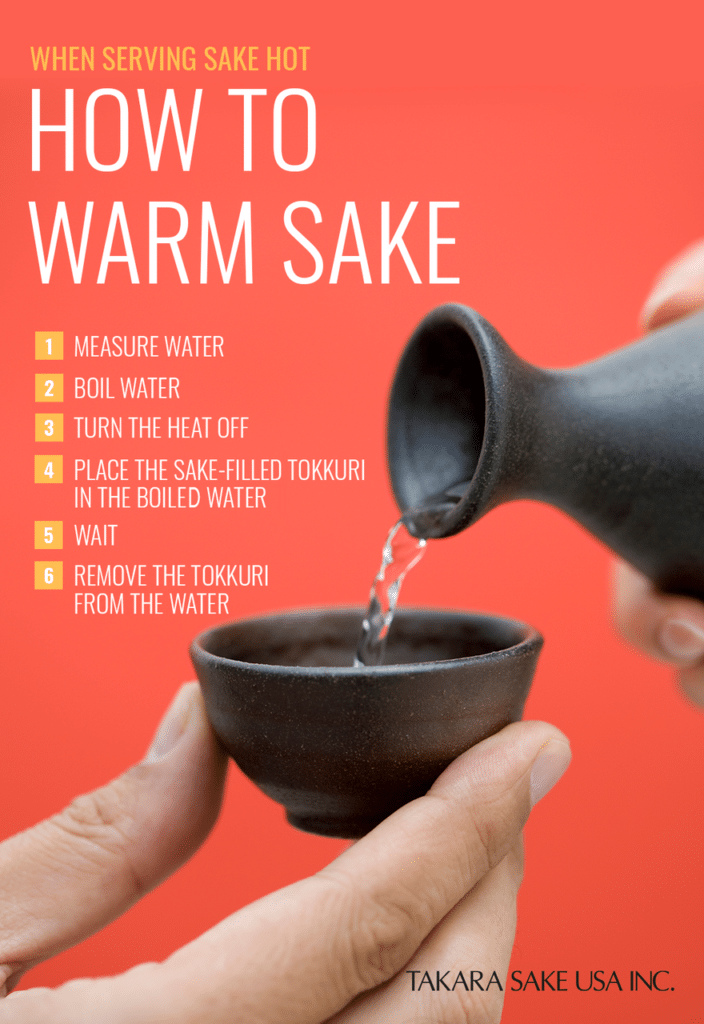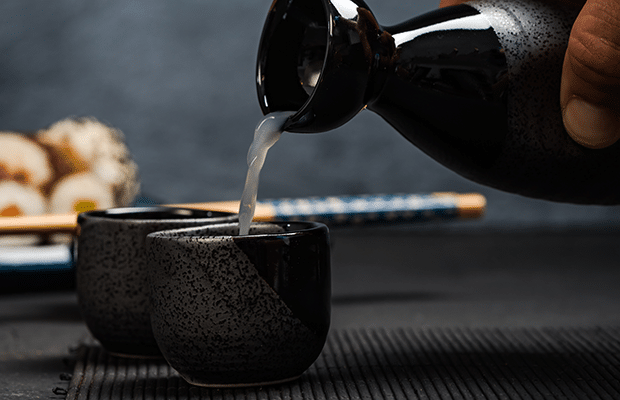Sake has been brewed in Japan for thousands of years
This alcoholic beverage is made by fermenting rice and has a taste and aroma unlike any other drink. Average sake contains an alcohol by volume (ABV) of 14% to 16% –– a good deal higher than wine or beer. When deciding which sake is right for you, it’s important to pay close attention to the label’s details and to your experience while taste testing.
Some traditions and manners surround the consumption of sake, including the serving temperature, how sake is poured and how the cup is held. But don’t get too overwhelmed by the rituals –– knowing the basics of sake consumption will allow you to enjoy this traditional Japanese drink just about anywhere.
If you’re curious about what sake tastes like, how to serve and drink sake and where to buy sake, we have the answers for you. We also offer an extensive Taste Profile Sheet for each product with serving and pairing suggestions. This sheet is downloadable from each product page for your reference.
How Do You Choose the Right Sake?

When it comes to sake, how do you choose the right drink? When selecting your sake, you’ll want to consider appearance, aroma, and taste. Test many sakes as you would with wine or beer to find the right sake for you.
1
Appearance
During a tasting, a tasting cup called a Kiki-choko may be used. To test the appearance of sake, fill a cup about 80% full with sake, and check the cloudiness and color of the liquid. The tasting cup has contrasting blue and white lines, so if these lines are clear, then the clarity of the sake is good. Ordinary sake has a light yellow or slightly amber hue, while older sake tends to be darker.
2
Aroma
To test the aroma of the sake, bring the tasting cup close and smell the sake. Then lower your nose to test the base fragrance.
3
Taste
The last test is of the flavor of the sake. With a small amount of sake, swirl it around your mouth to reach all of your tastebuds and breathe out slowly through your nose. When you do this, the aroma of the sake will fill your nose for a more enhanced impression of the sake’s aroma and taste. Test for flavors like sweet, acidic, bitter, and dry as well as how they’re balanced within the sake. Finally, test the aftertaste of the sake by swallowing it or spitting it out.
Taking appearance, aroma, and taste into consideration will help you decide which sake is best for you. Look for cloudiness, color, fragrance and flavor when testing your sake to find what you like best.
How Do You Serve Sake? Hot or Cold?

Temperature plays a role in the serving and consumption of sake. Sake can be served chilled, at room temperature, warm or hot, depending on the type of sake and the drinker’s preferences.
Junmai-style sake is the most versatile sake that you can serve chilled, room temperature, warm (100 to 105°F) or even hot. Most Junmai sake will become fuller, richer and start to show complex umami flavors when warmed.
In Japan, there are names for Junmai sake serving temperatures in 5°C increments. These names were established during the 19th century, known as the Edo period.
How Do You Warm Sake?


While a humid day may call for chilled sake, cold evenings in the winter may be better with hot sake. Warming sake perfectly is an art form in itself. Many traditional Japanese restaurants have a person whose only job is to watch for the subtle signs of the specific warming temperature of sake per their chef’s order or customer’s request. Trained eyes can catch the small bubble forming on the surface or the expansion of the liquid volume for each temperature increment.
We don’t have to be professional sake-warming masters, but we can certainly take a few tips from these trade experts. First of all, when warming sake, always remember to do so gradually and indirectly. In addition, never overheat sake, as you want to avoid the evaporation of alcohol so the subtle aromas of the sake do not dissipate with it. The boiling point of alcohol is 173°F (78.4°C), while the boiling point of water is 212°F (100°C). That means alcohol evaporates before water evaporates. Therefore, we do not recommend warming sake over 131°F (55°C).
We strongly suggest using a food-safe thermometer to monitor the temperature of the sake while it warms.
Here is how to warm sake with the water bath method:
- Measure water. Sake is traditionally served in a ceramic container called a tokkuri. Fill the tokkuri with sake, leaving approximately 1 inch of space from the top. This extra space is important for handling and pouring your drink later on. Place the sake-filled tokkuri in a saucepan and fill the pan with water to approximately two-thirds of the tokkuri’s height. After you measure the water, take the tokkuri out of the pan.
- Boil water. Bring water to a boil in the saucepan.
- Turn the heat off. After your water has boiled, turn the heat off.
- Remove the pan from the heat source. Some of the electronic stove tops might retain heat longer to continuously add excess heat to the water that you do not want.
- Place the sake-filled tokkuri in the boiled water.
- Wait. Use a thermometer to measure the desired temperature of the sake. In about two to three minutes, the sake’s temperature should reach about 104°F, depending on conditions.
- Remove the tokkuri from the water. Finally, you’ll remove the tokkuri containing your sake from your pan. Use a towel to dry off the outside of your tokkuri. Bring the tokkuri to the table and serve!
Be sure to follow these steps if you’re interested in serving your sake warm or hot. Avoid boiling the sake or using a microwave oven as either could ruin the flavor and aroma of the sake. You may also choose to serve the sake at room temperature, rather than hot. You can easily accomplish this by storing your sake in recommended conditions — refer to our sake storage tips — or allowing chilled sake to sit and warm up on its own to room temperature, tasting it occasionally to discover which temperatures you prefer your sake to be.
How Do You Serve Sake Cold?

While Junmai-style sake can be served warm, Junmai Ginjo or Junmai Daiginjo style sake is best served chilled to preserve the delicate floral and fruity aroma and flavors, which are enhanced by a chilled temperature. Chilled sake is increasingly being consumed before, during and after meals. Some sake is specifically produced to be chilled to about 50°F, but drinkers should exercise caution to avoid making sake too cold, as it can mask the flavor of the drink as it would for wine.
Here are a few steps you’ll want to follow for serving your sake:
- Remove chilled sake from the fridge. You can pour chilled sake directly into a cold sake glass or white wine glass to enjoy its aromas. You can also decant your sake into a carafe.
- Carafes for cold sake are available in materials such as glass or tin. Wrapping your carafe in a tea towel or napkin will catch any spills that may occur while you’re serving your sake.
How Do You Pour Sake?

Whether you are serving hot sake or cold sake, you can observe some sake etiquette of Japanese culture when pouring and receiving sake for and from your guests. These guidelines can help you experience some of the highly-valued courtesy and generous hospitality of Japanese culture, but there’s no reason to be intimidated by them –– nothing is formal.
Here are some guidelines:
- Offering sake. Think of others’ needs first. When the guest’s cup is less than one-third full, you can offer a fresh pour.
- Pour with both hands. Gently hold the tokkuri with both hands, holding it in your right hand and supporting the bottom with your left hand. When the guest is ready, pour the sake to the top of the cup.
- Receiving sake. When someone offers you sake, finish the remaining small sip in the cup. Then hold out the cup with one hand while supporting the bottom with the other hand. Once your cup is full, take a small sip before putting the cup back on the table. Then it is your turn to offer a fresh pour to the host or to other guests.
- Allow a guest to fill your cup. Tejaku — the act of filling up your own cup — is considered impolite. Let your guests take care of you, as much as you would take good care of your guests. Sake pouring and receiving is the exchange of appreciation for each other’s company. Both pouring and receiving sake is a great way to spend this wonderful time together.
Another option for serving sake is with a small box known as a masu, which is a receiving vessel for overflowed sake. Masu were originally used for measuring liquid and grain, such as rice, in Japan. A glass cup can be placed inside the masu, and sake can then be poured in the glass and intentionally overflowed into the masu. This style of serving is called sosogi koboshi and symbolizes the generous spirit of Japanese hospitality.
How Do You Drink Sake?


Along with serving sake, you may want to know how to drink sake according to tradition. Typically, sake is served in an ochoko, which is a small ceramic cup. Here’s how to drink sake from your ochoko in the traditional manner:
- Hold your ochoko with both hands. As with holding the tokkuri while serving, you’ll want to use both hands when holding your ochoko. With your right hand, hold the cup and support the bottom of the cup with your left hand. Continue holding the cup this way while you drink.
- Hold the cup out slightly. When being served, you’ll want to hold your cup out ahead slightly toward the person pouring your sake.
- Wait until everyone has been served and say, “Kanpai.” At the beginning of the event, don’t drink until everyone is served and you’ve all said, “Kanpai,” a way of saying cheers. When saying cheers, hold your cup with one hand and touch your ochokos carefully with others nearby. After saying kanpai, you’ll bring your cup in front of you and again hold it with both of your hands. Then take a small sip and allow it to sit in your mouth before swallowing it.
- Drink in small sips. Drink sip by sip, as sake is a strong drink. Ask for water along with your sake if desired, like having a chaser. The water served with sake is called yawaragi-mize, which means “calming water.”
- Finish your bottle of sake in a few hours. After opening your bottle of sake, you and your guests should consume the sake in three to four hours. An open bottle of sake will oxidize and affect the drink’s flavor. If the bottle isn’t finished within one sitting, store it in the fridge and finish the bottle in a few days.
Follow these steps for one way of experiencing the Japanese sake-drinking tradition. Keep in mind that sake is a strong drink with an average alcohol content per volume of 15%, so be sure you are aware of your personal limits when it comes to its consumption. When drinking a sweet sake, be especially cautious as you may be inclined to drink it quickly.
Find the sake of your choosing with us at Takara Sake
We’re the number one seller and producer of imported and domestic sake in the United States, shipping directly to customers across the country.

Now that you know how to pour and drink sake according to tradition, it’s time to cover where you can buy your sake.
Takara Sake USA distributes sake across the country and ships directly to consumers in 33 states via our online store. You can choose from our sakes such as:
- Sho Chiku Bai, a Junmai Daiginjo
- Sho Chiku Bai Shirakabegura, a Kimoto Junmai
- Sho Chiku Bai SHO, a Ginjo Nigori
This is just a very small sampling of the many sakes we offer, so you’ll be sure to find the sake of your choosing with us at Takara Sake USA.
After you’ve completed your purchase with us, keep these tips in mind:
- Store your sake refrigerated or in a dark, cool room if you aren’t planning on drinking it right away. Avoid exposure to direct or indirect light or heat, which can damage the drink.
- Except for sake that is aged well by professionals, sake is best consumed within a few months of purchase and within a few days of opening the bottle. Please refer to our sake storage tips for details.
Ready to make your purchase? Buy sake with us at Takara Sake USA today.
